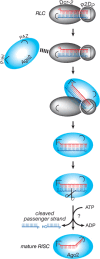Target selectivity in mRNA silencing
- PMID: 16520821
- PMCID: PMC7091803
- DOI: 10.1038/sj.gt.3302726
Target selectivity in mRNA silencing
Abstract
Despite the excitement and promise of RNA interference in treating neurodegenerative disease, disease gene mRNA might resist mRNA silencing. Conventional siRNA design does not uniformly distinguish a mutant from a wild-type allele. CAG expansions in trinucleotide repeat diseases are unselective targets for small siRNAs. This review will consider recent discoveries in mechanisms of RNA interference and siRNA modifications that improve siRNA selectivity, delivery and performance.
Gene Therapy (2006) 13, 509-516. doi:10.1038/sj.gt.3302726; published online 16 February 2006.
Figures


Similar articles
-
RNA-based drugs: from RNA interference to short interfering RNAs.Curr Pharm Biotechnol. 2004 Aug;5(4):361-8. doi: 10.2174/1389201043376797. Curr Pharm Biotechnol. 2004. PMID: 15320767 Review.
-
Potentiality of small interfering RNAs (siRNA) as recent therapeutic targets for gene-silencing.Curr Drug Targets. 2007 Mar;8(3):469-82. doi: 10.2174/138945007780058988. Curr Drug Targets. 2007. PMID: 17348839 Review.
-
Therapeutic potential of siRNA-mediated transcriptional gene silencing.Biotechniques. 2006 Apr;Suppl:7-13. doi: 10.2144/000112166. Biotechniques. 2006. PMID: 16629382 Review.
-
Mammalian RNAi: a practical guide.Biotechniques. 2005 Aug;39(2):215-24. doi: 10.2144/05392RV01. Biotechniques. 2005. PMID: 16116795 Review.
-
Silencing of genes responsible for polyQ diseases using chemically modified single-stranded siRNAs.Acta Biochim Pol. 2016;63(4):759-764. doi: 10.18388/abp.2016_1336. Epub 2016 Oct 21. Acta Biochim Pol. 2016. PMID: 27770571
Cited by
-
Mutant huntingtin, abnormal mitochondrial dynamics, defective axonal transport of mitochondria, and selective synaptic degeneration in Huntington's disease.Biochim Biophys Acta. 2012 Feb;1822(2):101-10. doi: 10.1016/j.bbadis.2011.10.016. Epub 2011 Nov 4. Biochim Biophys Acta. 2012. PMID: 22080977 Free PMC article. Review.
-
Multimodal Regulation Orchestrates Normal and Complex Disease States in the Retina.Sci Rep. 2017 Apr 6;7(1):690. doi: 10.1038/s41598-017-00788-3. Sci Rep. 2017. PMID: 28386079 Free PMC article.
-
Development of a 2',4'-BNA/LNA-based siRNA for Dyslipidemia and Assessment of the Effects of Its Chemical Modifications In Vivo.Mol Ther Nucleic Acids. 2012 Sep 18;1(9):e45. doi: 10.1038/mtna.2012.32. Mol Ther Nucleic Acids. 2012. PMID: 23344237 Free PMC article.
-
Therapeutic Strategies in Huntington's Disease.J Clin Neurol. 2006 Dec;2(4):213-24. doi: 10.3988/jcn.2006.2.4.213. Epub 2006 Dec 20. J Clin Neurol. 2006. PMID: 20396523 Free PMC article.
-
IL-1beta causes an increase in intestinal epithelial tight junction permeability.J Immunol. 2007 Apr 1;178(7):4641-9. doi: 10.4049/jimmunol.178.7.4641. J Immunol. 2007. PMID: 17372023 Free PMC article.
References
Publication types
MeSH terms
Substances
LinkOut - more resources
Full Text Sources
Other Literature Sources
Medical
Molecular Biology Databases

